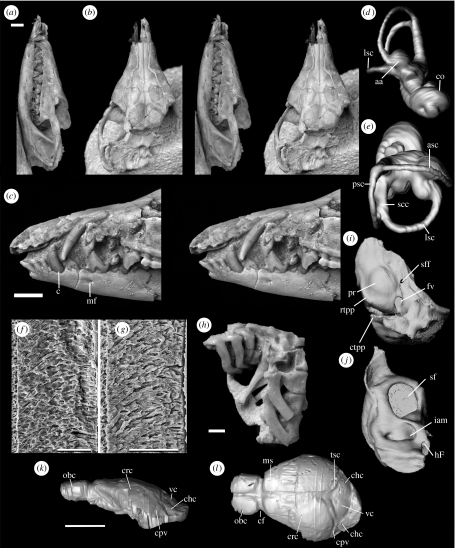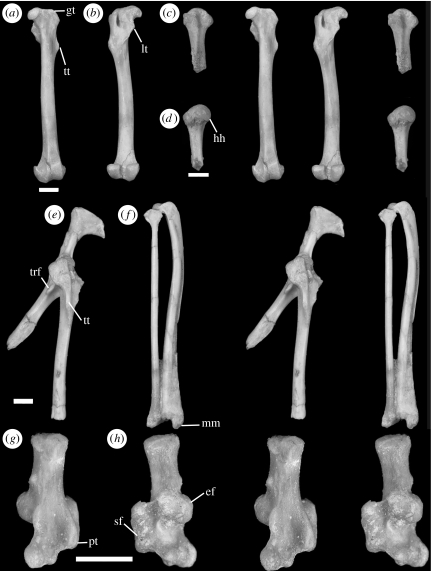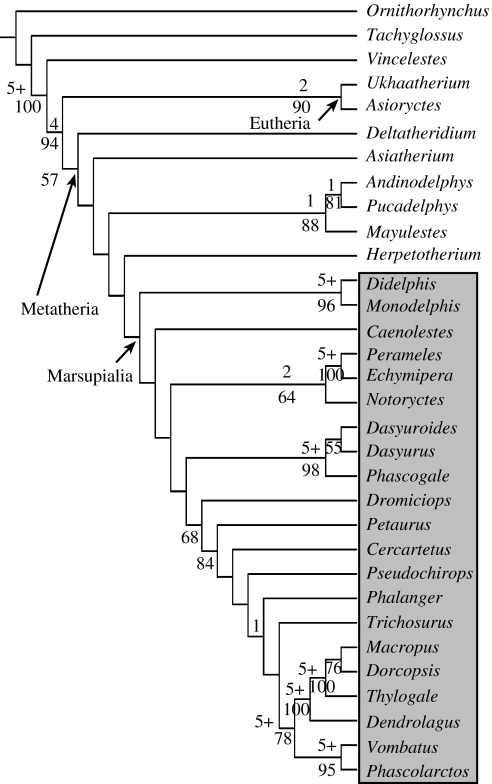Abstract
A major gap in our knowledge of the evolution of marsupial mammals concerns the Paleogene of the northern continents, a critical time and place to link the early history of metatherians in Asia and North America with the more recent diversification in South America and Australia. We studied new exceptionally well-preserved partial skeletons of the Early Oligocene fossil Herpetotherium from the White River Formation in Wyoming, which allowed us to test the relationships of this taxon and examine its adaptations. Herpetotheriidae, with a fossil record extending from the Cretaceous to the Miocene, has traditionally been allied with opossums (Didelphidae) based on fragmentary material, mainly dentitions. Analysis of the new material reveals that several aspects of the cranial and postcranial anatomy, some of which suggests a terrestrial lifestyle, distinguish Herpetotherium from opossums. We found that Herpetotherium is the sister group to the crown group Marsupialia and is not a stem didelphid. Combination of the new palaeontological data with molecular divergence estimates, suggests the presence of a long undocumented gap in the fossil record of opossums extending some 45 Myr from the Early Miocene to the Cretaceous.
Keywords: phylogeny, adaptation, Marsupialia
1. Introduction
The earliest history of Metatheria, the group including extant marsupials and all extinct mammals more closely related to marsupials than to placentals, is becoming increasingly well known due to the discovery of exceptional skeletons from the Cretaceous of Asia (Luo et al. 2003). North America also has a diverse history of metatherians from the Cretaceous through the Miocene, but this record is mainly based on isolated skeletal remains, especially teeth (Kielan-Jaworowska et al. 2004). The two living species of opossum in North America are geologically recent immigrants from South America.
The Miocene fossil record of South America and Australia contains well-preserved skeletons that document the diversification of crown Marsupialia in these continents, but the only detailed record between these geologically recent fossils and Cretaceous forms are the Paleocene skeletons of basal metatherians from Bolivia (Muizon et al. 1997) and the two-dimensional ones from the Middle Eocene of Messel in Germany (Kurz 2005). Several additional metatherian clades are known from the ca 45 Myr time-interval ranging from the Early Miocene to the Late Cretaceous, but most taxa are based on isolated skeletal remains, especially teeth (Luo et al. 2003).
One of these groups is the Herpetotheriidae (Herpetotheriinae of McKenna & Bell 1997), consisting of superficially opossum-like species distributed from the Late Cretaceous (Martin et al. 2005) to the Miocene. Herpetotheriids are known from North America, Europe, Asia, Africa and possibly South America (Goin & Candela 2004). They are usually placed with the Didelphidae and Caluromyidae in the ‘Didelphimorphia’, together with other superficially primitive-looking and opossum-like forms (Kirsch et al. 1997). The phylogenetic placement of Herpetotheriidae has been informal and based on inferences made from the study of just teeth. The dental similarity of herpetotheriids to modern forms led Simpson (1942, p. 39) to refer to opossums as ‘little changed… since [the] Late Cretaceous’. To test this association in a cladistic framework, we studied exceptionally well-preserved three-dimensional cranial and postcranial bones of Herpetotherium from the Early Oligocene, which allowed us to study its adaptations and relationships among metatherians.
2. Material and methods
Two fairly complete skulls and associated postcranial bones from the White River Formation, ca 33 Myr old (Evanoff et al. 1992) were identified as Herpetotherium fugax based on dental features (electronic supplementary material).
We conducted a phylogenetic analysis of basal metatherian taxa with mostly complete skeletons. The matrix of 245 characters and 568 character states results from our extensive examination of craniodental and postcranial characters (electronic supplementary material). Twenty-seven metatherian taxa were coded, with representatives of all major living clades, the three Tiupampa metatherians known from almost complete skeletons (Muizon et al. 1997), two additional stem metatherians and five non-metatherian taxa as out-groups. We excluded Sinodelphys szalayi from the analysis because its preservation prevents coding more than 80% of the characters.
3. Results and discussion
(a) Anatomy
The dental formula is the plesiomorphic one for metatherians: 5134/4134. In an M3, a single layer of radial enamel (with parallel prism orientation) was detected, the plesiomorphic therian condition and the most common enamel type among marsupials. Enamel tubules and Hunter–Schreger bands are absent (figures 1 and 2).
Figure 1.
Herpetotherium fugax. Stereophotographs of (a) left lateral view and (b) dorsal view of skull PIMUZ (Palaeontological Institut and Museum Zürich) 2613 and (c) anterior left portion of skull ZMB (Museum für Naturkunde Berlin) 50671. Scale bar, 2 mm. Cast as reconstructed by computed tomography in ZMB 50672 of the left bony labyrinth in (d) anterior view and (e) lateral view, and of the left petrosal in (i) ventral view and (j) dorsal view. Not to scale. The arrow in (e) points to the second common crus. Enamel microstructure of M3 of ZMB 50672, longitudinal sections. Occlusal surface to the top, enamel–dentine junction to the left. (f) Mesial flank of protocone, (g) middle stylar cusp. Scale bar, 30 μm. Cervical (5–7) and thoracic (1–5) vertebrae in ZMB 50671 (h). Scale bar, 2 mm. Left (k) lateral view and (l) dorsal view of digital cranial endocast of ZMB 50672. Scale bar, 5 mm. Abbreviations: aa, anterior ampulla; asc, anterior semicircular canal; c, canine; cf, circular fissure; chc, cerebellar hemisphere cast; co, cochlea; cpv, cast of prootic vein; crc, cerebral hemisphere cast; ctpp, caudal tympanic process of the petrosal; fv, fenestra vestibule; hF, hiatus Fallopii; iam, internal acoustic meatus; lsc, lateral semicircular canal; mf, mental foramen; ms, median sulcus; obc, olfactory bulb cast; pr, promontorium; psc, posterior semicircular canal; rtpp, rostral tympanic process of the petrosal; scc, second common crus; sf, subarcuate fossa; sff, secondary facial foramen; tsc, transverse sinus cast; vc, vermis cast.
Figure 2.
Stereophotographs of postcranial elements in H. fugax ZMB 50671. Left femora in (a) anterior view and (b) posterior view. Left proximal humerus in (c) anterior view and (d) posterior view. Left pelvis portion and articulated proximal femur in (e) lateral view. Left articulated tibia and fibula in (f) posterior view. Right calcaneum in (g) ventrolateral view and (h) dorsomedial view. Scale bar, 2 mm. Abbreviations: ef, ectal facet; gt, greater trochanter; hh, humeral head; lt, lesser trochanter; mm, medial malleolus; pt, plantar tubercle; sf, sustentacular facet; trf, tuberosity for rectus femoris; tt, third trochanter.
The overall morphology of the cranial endocast is similar to that of didelphids. The endocranial volume is 25% smaller than that of a 57-day-old Monodelphis of comparable skull length. The cerebral hemisphere casts are lissencephalic and a rhinal fissure is not visible.
The most remarkable aspect of the bony labyrinth is that the posterior arm of the lateral semicircular canal and the inferior arm of the posterior semicircular canal build a second common crus, present in several basal marsupials. The 1.6 cochlear turns is a low number, similar to that of basal metatherians and less than the typical 2.4 of didelphids (Meng & Fox 1995).
The femur bears a robust third trochanter, absent in didelphids and in australidelphians (Szalay & Sargis 2001). Several features suggest a powerful M. quadriceps, usual in agile scansorial and terrestrial taxa. These include a distinct pelvic tuberosity for the rectus femoris, the anterior protrusion of the greater trochanter and the presence of a crest for the vastus lateralis on the femur, a distal femoral epiphysis slightly deeper than wide in distal view, a well-defined femoral trochlea between sharp crests and a triangular cross-section of the tibia due to a sharp anterior crest.
The orientation of the sustentacular facet of the calcaneum indicates that the astragalus was not superimposed on the calcaneum in its distal region. The sustentacular facet is oriented mediodorsally in its proximal region and ends distally, practically medially directed. Therefore, the astragalar head lies medial to the distal area of the calcaneum. Other metatherians that display this primitive therian condition are Mayulestes, Pucadelphys and Deltatheridium. Crown group marsupials and eutherians display convergently a completely superimposed astragalus and calcaneum (Horovitz 2000). Astragalar shape is consistent with terrestrial habits (electronic supplementary material).
(b) Phylogenetic relationships
The phylogenetic analyses placed Herpetotherium as the sister group to crown marsupials, not as a basal didelphid (figure 3).
Figure 3.
Strict consensus tree based on parsimony analysis of 245 characters to study the phylogenetic relationships of Herpetotherium. There are three most parsimonious tress at 868 steps (CI=0.370; RI=0.649). Numbers at nodes are the Bremer (above) and bootstrap values (below). The crown-group Marsupiala, in the shaded box, is the sister group of Herpetotherium.
The oldest known fossil record of opossums (Didelphidae) is from the Early Miocene of Patagonia (Goin et al. in press), but molecular divergence date estimates suggest that Didelphidae diverged from the rest of crown marsupials during the Late Cretaceous (Nilsson et al. 2004). Therefore, our conclusions that the pre-Pleistocene metatherians of North America are not referable to the Didelphidae, suggest that there is a long gap in the fossil record of opossums extending for ca 45 Myr.
Since the Paleogene fossil record of small mammals in North America is well studied, the supposed absence of didelphids at this time in North America may be relevant. Despite informal statements describing opossums as living fossils (cf. Simpson 1942), there are not yet any unequivocal records of pre-Miocene didelphids. They are also absent from Paleogene rocks of South America, although the record there is largely confined to the southern cone. We suspect that stem group didelphids inhabited northern South America in the Paleogene. The highest diversity of living didelphids is in the northern neotropics; a region reported to have served as a cradle for other lineages that were extirpated elsewhere in their range (Jablonski et al. 2006).
(c) Functional anatomy and character evolution
Comparisons of extant opossums with basal opossum-like metatherians like Herpetotherium reveal that the living forms are characterized by a series of derived features in their cranial and postcranial anatomy. This includes a subterminal position of the calcaneal sustentaculum, the absence of a calcaneal facet for the fibula, the presence of a notch for the cuboid pivot, a reduction of the mastoid tympanic process and an increased number of cochlear turns, among others.
The clade containing Herpetotherium and Marsupialia is supported by seven unambiguous synapomorphies from the skull, dentition and postcranial skeleton (electronic supplementary material). Within the herpetotheriid clade, Herpetotherium has lost the staggered condition of the lower i3. This has also happened in the microbiotheriid clade, suggesting that the absence of a staggered i3 in Dromiciops is apomorphic.
Terrestrial habitat use, reconstructed here for Herpetotherium, is in congruence with data from the only other herpetotheriids known from significant skeletal material (Kurz 2005). The oldest metatherian Sinodelphys szalayi is reported to have been arboreal (Luo et al. 2003). Terrestrial habitats reconstructed for Herpetotherium suggests that multiple evolutionary transformations occurred along the stem leading to the crown, or less likely, that Sinodelphys is derived in its arboreal habits and basal metatherians were terrestrial.
4. Conclusion
Since herpetotheriids are opossum-like and have a distribution from the Late Cretaceous to the Miocene, they were first deemed to be stem didelphids and fill that gap in the fossil record. However, the position of Herpetotherium outside of Marsupialia contradicts this and suggests instead that there is a major gap in the fossil record of opossums extending for nearly 45 Myr.
At the time H. fugax was alive in Wyoming, the extant clades of didelphids had probably not yet fully radiated in South America according to molecular divergence date estimates (Steiner et al. 2005). Didelphids eventually reached a sizeable diversification of approximately 85 species in the Americas today. Whereas in tropical South America and Australia, marsupials attained considerable taxonomic and ecological diversity (Goin & Candela 2004), the diversity of metatherians across the Northern Hemisphere remained limited throughout the Early Cenozoic and was capped by their extinction in the Miocene.
Acknowledgments
We thank M. Aberhan, R. Beck, A. Benz, L. Bernor, C. Collins, J. Cuisin, H. Furrer, M. Hebeisen, K. Krohmann, F. Renoult, H.-P. Schultze and the Synthesys Programme of the European Union for their support, technical help and discussions.
Supplementary Material
Measurements, data matrix and descriptions
References
- Evanoff E, Prothero D, Lander R. Eocene–Oligocene climatic change in North America. In: Prothero D, Beggren W, editors. Eocene–Oligocene climatic and biotic evolution. Princeton University Press; Princeton, NJ: 1992. pp. 116–130. [Google Scholar]
- Goin, F. J., Candela, A. M. 2004 New Paleogene marsupials from the Amazonian basin. In The Paleogene mammalian fauna of Santa Rosa, vol. 40 (ed. K. E. Campbell). Natural History Museum of Los Angeles County Science Series, pp. 15–16. Los Angeles, CA: Natural History Museum of Los Angeles County.
- Goin, F. J., Abello, A., Bellosi, E., Kay, R. F., Madden, R. H. & Carlini, A. A. In press. Los Metatheria sudamericanos de comienzos del Neógeno. Ameghiniana
- Horovitz I. The tarsus of Ukhaatherium nessovi (Eutheria, Mammalia) from the Late Cretaceous of Mongolia. J. Vertebr. Paleontol. 2000;20:547–560. doi:10.1671/0272-4634(2000)020[0547:TTOUNE]2.0.CO;2 [Google Scholar]
- Jablonski D, Roy K, Valentine J. Out of the tropics. Science. 2006;314:102–106. doi: 10.1126/science.1130880. doi:10.1126/science.1130880 [DOI] [PubMed] [Google Scholar]
- Kielan-Jaworowska Z, Cifelli R.L, Luo Z.-X. Columbia University Press; New York, NY: 2004. Mammals from the age of dinosaurs: origins, evolution, and structure. [Google Scholar]
- Kirsch J.A.W, Lapointe F.-J, Springer M.S. DNA-hybridization studies of marsupials and their implications for metatherian classification. Aust. J. Zool. 1997;45:211–280. doi:10.1071/ZO96030 [Google Scholar]
- Kurz C. Ecomorphology of opossum-like marsupials from the Tertiary of Europe. Kaupia. 2005;14:21–26. [Google Scholar]
- Luo Z.-X, Qiang A, Wible J.R, Yuan C. An early Cretaceous tribosphenic mammal and metatherian evolution. Science. 2003;302:1934–1940. doi: 10.1126/science.1090718. doi:10.1126/science.1090718 [DOI] [PubMed] [Google Scholar]
- Martin J.E, Case J.A, Jagt J, Schulp A.S, Mulder E. A new European marsupial indicates a Late Cretaceous high-latitude transatlantic dispersal route. J. Mammal. Evol. 2005;12:495–511. doi:10.1007/s10914-005-7330-x [Google Scholar]
- McKenna M.C, Bell S.K. Columbia University Press; New York, NY: 1997. Classification of mammals. [Google Scholar]
- Meng J, Fox R.C. Osseous inner ear structures and hearing in early marsupial and placentals. Zool. J. Linn. Soc. 1995;115:47–71. doi:10.1006/zjls.1995.0033 [Google Scholar]
- Muizon C, Cifelli R.L, Paz C.R. The origin of the dog-like borhyaenoid marsupials of South America. Nature. 1997;370:486–489. doi: 10.1038/39029. doi:10.1038/39029 [DOI] [PubMed] [Google Scholar]
- Nilsson M, Arnason U, Spencer P.B.S, Janke A. Marsupial relationships and a timeline for marsupial radiation in South Gondwana. Gene. 2004;340:189–196. doi: 10.1016/j.gene.2004.07.040. doi:10.1016/j.gene.2004.07.040 [DOI] [PubMed] [Google Scholar]
- Simpson G.G. Columbia University Press; New York, NY: 1942. Tempo and mode in evolution. [Google Scholar]
- Steiner C, Tilak M, Douzery E, Catzeflis F.M. New data from a transthyretin nuclear intron suggest an Oligocene to Miocene diversification of living South America opossums. Mol. Phylogenet. Evol. 2005;35:363–379. doi: 10.1016/j.ympev.2004.12.013. doi:10.1016/j.ympev.2004.12.013 [DOI] [PubMed] [Google Scholar]
- Szalay F.S, Sargis E. Model-based analysis of postcranial osteology of marsupials from the Palaeocene of Itaboraí. Geodiversitas. 2001;23:139–302. [Google Scholar]
Associated Data
This section collects any data citations, data availability statements, or supplementary materials included in this article.
Supplementary Materials
Measurements, data matrix and descriptions





